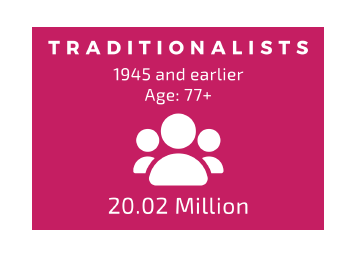
Generational Marketing – Traditionalists
Traditionalists include those aged 77+ and will be a key group when it comes to your planned giving outreach.
Learning how to communicate with this portion of the population is important for your success. Discovering the nuances and what makes this group different will allow you to interact with intent and respect.

The world has changed drastically over the course of a traditionalists’ life. They have experienced major shifts in every facet of life. Most of us have not experienced what it’s like to be in this final stage. As fundraisers, we must educate ourselves on how to properly communicate with this mature audience so we do not alienate or frustrate this donor base. Below are a few notes on ways to communicate, market, and interact with the eldest of donors.
Communication:
This generation responds best to personal and direct communications. The more personal, the better.
1. Face-to-face interactions
-
-
- In person meetings with their schedule in mind
- Meet where they feel most comfortable (their home, a quite coffee shop or diner, your office)
-
2. Personal phone calls
-
-
- Make calls yourself or have a dedicated gift officer call
- Do your research before you call. Know personal information (preferred name, the name of their spouse, the name of their pet, recent events in their lives)
-
3. Handwritten notes and letters
-
-
- Thank you notes or letters written out (as opposed to being typed) show you have taken the time to communicate
-
Marketing:
Your marketing materials should be designed with this group in mind. Larger fonts, more white space, and appropriate imagery should be used.
1. Print materials
-
-
- Watch your grammar and manners
- Use images that depict life – not aging
-
2. Direct Mail
-
-
- Postcards, pamphlets, self-mailers
- Include multiple ways for donors to get in contact with you
- Include a picture of yourself
-
3 Tips:
1. Use simple, straightforward content and imagery
-
-
- Stay away from technical terms and instead use everyday language
- Use imagery that depicts living
- Deliver your message based on the history and traditions of your organization – help your donors feel as though they belong
-
2. Do not take their loyalty for granted
-
-
- Recognize their continued support
- Show that you know they are an important part of your organization
-
3. Show respect and up your ‘thank-you’ game
-
-
- Address as Mr., Mrs., Sir, Ma’am – use first names when instructed
- Listen first, then ask clarifying questions to demonstrate that you’re listening closely
-
Future Training Thursdays will center around
other generations you will come in contact with:


70 ½ vs. 73?
70 ½ vs. 73? We’ve been hearing some confusion from a lot of clients around the age split of 70 ½ vs. 73 for gifting from an IRA. Which is the correct age? What are the rules around each age? When it comes to marketing this great gifting strategy, the problem is both...

Wisdom Wednesday – Are you 85?
Are you 85? I didn't think so ...We've talked about the mindset of our most senior donors in the past. And we'll most likely talk about it forever. Why? None of us know what it's like to be 85 - unless we're 85.We've all been 16 before. Most of us have even recovered...
Tech Tuesday – IRS Discount Rate
IRS Discount Rate With the signing of the Consolidated Appropriations Act of 2023 and the provision referred to as Secure 2.0, there is newfound interest around Charitable Gift Annuities* (CGAs). Because of this we’re all becoming reacquainted with the IRS...

Wisdom Wednesday – Planning for 2023
Planning for 2023 New year, new view on planned giving fundraising Look at it from your donor’s point of view, understand what they need and want, not what your organization needs or wants. The new year is a great time to pause, reflect, and reset. Most of us think...
